The lasting appeal of the Disney brand can likely be ascribed in part to the origin myths that surround the company’s founding. Everyone knows “it was all started by a mouse”, and the dedication of Disneyland, “to all who come to this happy place, welcome,” is more entrenched in the cultural consciousness than a majority of inauguration speeches made by U.S. presidents. The lands found in the parks themselves are frequently origin stories, most notably Main Street U.S.A. in both Disneyland and The Magic Kingdom which mythologizes Walt’s adolescent roots as an American dreamer. Even after Walt, the EPCOT Center had a special creation myth as well, retold by fans about the original vision for an “Experimental Prototype Community of Tomorrow” and how it evolved into the Epcot we know today. These original parks in the Disney family are often considered timeless creations, whereas Disney’s Hollywood Studios (formerly Disney-MGM Studios before the licensing contract expired) would probably rather we forget the time of its creation altogether. Its origin story goes something like this:
When Universal Studios announced their plans to build a movie theme park in Orlando, Michael Eisner quickly scrambled together a press conference to announce his own plans for a third gate at Walt Disney World, which looked suspiciously identical to the proposed movie theme from their soon-to-be competitors. Using some ride concepts from unused proposals for their existing parks, Disney-MGM Studios managed to complete a year ahead of Universal Studios despite the later construction start, partly thanks to the Disney Company’s special jurisdiction in Florida that lets them issue their own construction permits. Upon opening their gates, visitors to Disney-MGM Studios were treated to a grand total of four different attractions to fill out their day of adventure, as well as a separate movie production studio which gave us such classics as Ernest Saves Christmas and Thunder in Paradise before it was eventually downsized back to California… not that that fact should be any reason they can’t still pretend that we get to watch real movies and television be made.
park in Orlando, Michael Eisner quickly scrambled together a press conference to announce his own plans for a third gate at Walt Disney World, which looked suspiciously identical to the proposed movie theme from their soon-to-be competitors. Using some ride concepts from unused proposals for their existing parks, Disney-MGM Studios managed to complete a year ahead of Universal Studios despite the later construction start, partly thanks to the Disney Company’s special jurisdiction in Florida that lets them issue their own construction permits. Upon opening their gates, visitors to Disney-MGM Studios were treated to a grand total of four different attractions to fill out their day of adventure, as well as a separate movie production studio which gave us such classics as Ernest Saves Christmas and Thunder in Paradise before it was eventually downsized back to California… not that that fact should be any reason they can’t still pretend that we get to watch real movies and television be made.
In retrospect the origins of today’s Disney’s Hollywood Studios probably seem a bit silly and misguided. Even given that it has higher annual attendance than Universal Studios by virtue of being part of the Disney World package,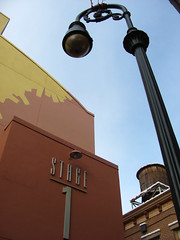 as the smallest of three (now four) gates the motivation for Disney’s Studios park to compete would never be as great as Universal’s focus of resources would be on their flagship property. The similarities and differences between the two parks today are telling. Both promised a peek behind the scenes of moviemaking even though both have ill-fated histories of actual movie production in Florida, and both have relatively uninspiring visual identities, simulating soundstages and movie sets that even if real wouldn’t have much innate aesthetic appeal anyway.1 Both parks also tend to be treated as the dumping grounds for intellectual properties their parent companies want to build a ride out of but wouldn’t quite fit behind their other more thematically structured gates.
as the smallest of three (now four) gates the motivation for Disney’s Studios park to compete would never be as great as Universal’s focus of resources would be on their flagship property. The similarities and differences between the two parks today are telling. Both promised a peek behind the scenes of moviemaking even though both have ill-fated histories of actual movie production in Florida, and both have relatively uninspiring visual identities, simulating soundstages and movie sets that even if real wouldn’t have much innate aesthetic appeal anyway.1 Both parks also tend to be treated as the dumping grounds for intellectual properties their parent companies want to build a ride out of but wouldn’t quite fit behind their other more thematically structured gates.
However, where Universal Studios Florida became big and muscular by adding major attractions on a frequent basis whether they fit the surrounding environment or not, Disney’s Hollywood Studios’ growth has been more conservative, with fewer total E-ticket attractions that also tend to be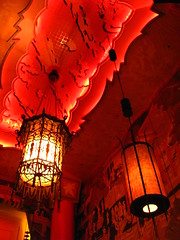 of more even quality, which has left many of the original themed environments still cohesively intact. There are more pathways and buildings around Hollywood Studios that are pleasurable to simply explore or admire the historical references at one’s own leisure (e.g. Sunset Blvd., Echo Lake), whereas Universal Studios emphasizes action with design choices intended to funnel us into the queue of the nearest attraction. Perpetually compared to the other three theme parks on Walt Disney World’s property, it can be easy to forget that if on its own Disney’s Hollywood Studios would still be a relatively beautiful park when inspected up close.
of more even quality, which has left many of the original themed environments still cohesively intact. There are more pathways and buildings around Hollywood Studios that are pleasurable to simply explore or admire the historical references at one’s own leisure (e.g. Sunset Blvd., Echo Lake), whereas Universal Studios emphasizes action with design choices intended to funnel us into the queue of the nearest attraction. Perpetually compared to the other three theme parks on Walt Disney World’s property, it can be easy to forget that if on its own Disney’s Hollywood Studios would still be a relatively beautiful park when inspected up close.
The fact is easily forgotten because, stepping back from each example of the wonderful attention to detail and examining the park grounds as a whole, Disney’s Hollywood Studios has a fairly monotonous aesthetic identity, roughly divided into two sprawling sections: the Golden Age Tinseltown look in the northern half and the studio soundstage look on the south side, with a few lone areas of IP-based attractions adding discontinuous lumps to the mix. While the other Walt Disney World parks use their environments to evoke universal stories of reassurance, wonder, or nature, Hollywood Studios by contrast is both narrow in concept and narcissistic in delivery. It’s a vanity project designed primarily to please the old guard of Hollywood executives who built it in the first place. A place to reminisce over how easy it used to be to deceive audiences with either a little glitz and glamour on the red carpet or some make-up and special effects on the silver screen, while assuming that modern audiences still share that same nostalgic desire to be duped by these manufactured illusions of the culture industry.2 The phrase “you ought to be in pictures” is glimpsed several times to remind us that the ability to make it into Hollywood should still be considered the highest endorsement of an individual’s beauty and self-worth, even if most people today would interpret such a sentiment as cutely quaint rather than truly honorary. Therefore it’s perhaps of interest to note that two of the most original attractions, The Twilight Zone Tower of Terror and Muppet*Vision 3D, are both to some degree deconstructions of the vainglorious attitudes towards movie magic that define the rest of this theme park.
by contrast is both narrow in concept and narcissistic in delivery. It’s a vanity project designed primarily to please the old guard of Hollywood executives who built it in the first place. A place to reminisce over how easy it used to be to deceive audiences with either a little glitz and glamour on the red carpet or some make-up and special effects on the silver screen, while assuming that modern audiences still share that same nostalgic desire to be duped by these manufactured illusions of the culture industry.2 The phrase “you ought to be in pictures” is glimpsed several times to remind us that the ability to make it into Hollywood should still be considered the highest endorsement of an individual’s beauty and self-worth, even if most people today would interpret such a sentiment as cutely quaint rather than truly honorary. Therefore it’s perhaps of interest to note that two of the most original attractions, The Twilight Zone Tower of Terror and Muppet*Vision 3D, are both to some degree deconstructions of the vainglorious attitudes towards movie magic that define the rest of this theme park.
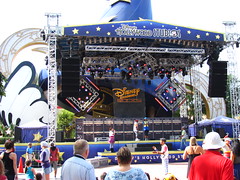 All told Disney’s Hollywood Studios is still a worthwhile entry amongst Central Florida’s theme park selection, if not only because it has a collection of attractions with greater appeal to most ride enthusiasts than the average Disney park. Perhaps what it needs more than anything else could be as simple as a proper central icon instead of the Sorcerer’s Hat placed there “temporarily” since 2001. Something that could give the complete park a more unified, universal message, instead of a slapdash icon reminding us of the park’s slapdash heritage built by competing corporate egos with evidently very little imagination left in the world.
All told Disney’s Hollywood Studios is still a worthwhile entry amongst Central Florida’s theme park selection, if not only because it has a collection of attractions with greater appeal to most ride enthusiasts than the average Disney park. Perhaps what it needs more than anything else could be as simple as a proper central icon instead of the Sorcerer’s Hat placed there “temporarily” since 2001. Something that could give the complete park a more unified, universal message, instead of a slapdash icon reminding us of the park’s slapdash heritage built by competing corporate egos with evidently very little imagination left in the world.
The Great Movie Ride
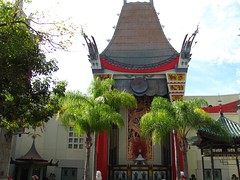 Here’s a dark ride built by geeks for geeks. At first the uninspired descriptive title and central placement as Hollywood Studio’s “mascot” attraction (à la Cinderella Castle or Spaceship Earth, this time with Mann’s Chinese Theatre) made me fear this could be a very vanilla work of Hollywood pageantry, overproduced as only Disney knows how. Thankfully that’s not (entirely) the case, as the show producers seem to demonstrate a genuine giddy enthusiasm for toying with many conventions of theme park attractions while simultaneously flattering our pop-culture savvy. Like, “wouldn’t-it-be-cool-if-the-ride-host-gets-kidnapped-by-a-villain-from-a-gangster-flick-or-spaghetti-western”, and “wouldn’t-it-be-cooler-if-then-the-gangster-gets-owned-by-the-xenomorph-from-Alien”, but then “wouldn’t-it-be-coolest-if-he-gets-his-
Here’s a dark ride built by geeks for geeks. At first the uninspired descriptive title and central placement as Hollywood Studio’s “mascot” attraction (à la Cinderella Castle or Spaceship Earth, this time with Mann’s Chinese Theatre) made me fear this could be a very vanilla work of Hollywood pageantry, overproduced as only Disney knows how. Thankfully that’s not (entirely) the case, as the show producers seem to demonstrate a genuine giddy enthusiasm for toying with many conventions of theme park attractions while simultaneously flattering our pop-culture savvy. Like, “wouldn’t-it-be-cool-if-the-ride-host-gets-kidnapped-by-a-villain-from-a-gangster-flick-or-spaghetti-western”, and “wouldn’t-it-be-cooler-if-then-the-gangster-gets-owned-by-the-xenomorph-from-Alien”, but then “wouldn’t-it-be-coolest-if-he-gets-his- face-melted-like-the-guy-in-Indiana-Jones-and-the-guardian-of-the-Ark-of-the-Covenant-turns-out-is-the-original-ride-host-in-disguise”? (Deep breath.) Given how many different ideas the Imagineers tried to cram together The Great Movie Ride easily could have suffered from over complication, but… well, okay, it is a little over complicated. Sure that’s part of the charm, but mixing live performers with audio-animatronics on the same stage almost always produces extra awkward results, and the script’s handful of “spontaneous surprises” often play stale or forced, simply due to the nature of a theme park attraction that requires casts members to read the same lines every twenty minutes every day for the rest of their career. The Great Movie Ride wants us to admire its cleverness and craftsmanship, but it’s mostly just an expensive work of fan fiction; an emotional parasite
face-melted-like-the-guy-in-Indiana-Jones-and-the-guardian-of-the-Ark-of-the-Covenant-turns-out-is-the-original-ride-host-in-disguise”? (Deep breath.) Given how many different ideas the Imagineers tried to cram together The Great Movie Ride easily could have suffered from over complication, but… well, okay, it is a little over complicated. Sure that’s part of the charm, but mixing live performers with audio-animatronics on the same stage almost always produces extra awkward results, and the script’s handful of “spontaneous surprises” often play stale or forced, simply due to the nature of a theme park attraction that requires casts members to read the same lines every twenty minutes every day for the rest of their career. The Great Movie Ride wants us to admire its cleverness and craftsmanship, but it’s mostly just an expensive work of fan fiction; an emotional parasite that survives by feeding off superior works of art. Sure the satisfaction of winning a game of “Spot the Movie References” can be real, it’s just also not very deep.
that survives by feeding off superior works of art. Sure the satisfaction of winning a game of “Spot the Movie References” can be real, it’s just also not very deep.
Grade: C+
Indiana Jones Epic Stunt Spectacular!
Of course everything at a Disney park is fake, but sometimes the fakery is directly acknowledged while (most) other times our disbelief is supposed to be suspended indefinitely. There’s an extended bit where one of the group of audience members they bring on stage is actually a plant, which our initial ignorance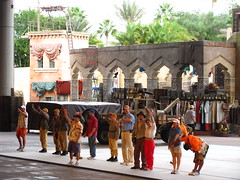 of the confederate’s presence allows for some amusing did-that-really-just-happen gags. When the set culminates in an outrageous stunt that instantly clues everyone into the act, the show wisely doesn’t try to stretch our disbelief any further and immediately acknowledges the ruse so that everyone can authentically cheer a fine performance (one most didn’t even realize was a performance twenty seconds earlier). Well played, and enjoyable entertainment. Given that the majority of the Indiana Jones Epic Stunt Spectacular doesn’t try to be a work of theater but just an honest demonstration of the physical stunts and special effects that make movie magic, it’s therefore more conspicuously odd when the show writers do try to enforce an obviously fictional conceit. The worst offender is the repeated claims to convince us this set is actually used
of the confederate’s presence allows for some amusing did-that-really-just-happen gags. When the set culminates in an outrageous stunt that instantly clues everyone into the act, the show wisely doesn’t try to stretch our disbelief any further and immediately acknowledges the ruse so that everyone can authentically cheer a fine performance (one most didn’t even realize was a performance twenty seconds earlier). Well played, and enjoyable entertainment. Given that the majority of the Indiana Jones Epic Stunt Spectacular doesn’t try to be a work of theater but just an honest demonstration of the physical stunts and special effects that make movie magic, it’s therefore more conspicuously odd when the show writers do try to enforce an obviously fictional conceit. The worst offender is the repeated claims to convince us this set is actually used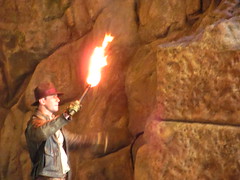 for filming movies, as if studio films are produced with live studio audiences and being a Harrison Ford stunt double for the Indiana Jones franchise is a steady career with regular 9-5 working hours, ideal for the muscular 20-something theater grads they’ve hired. Maybe this premise worked for one year in 1989 when this show first debuted and the Last Crusade opened in theaters featuring a still youthful Mr. Ford, but today it’s just a distracting reminder of how Disney can’t be bothered to update even a few lines of script for a live performance in over twenty years. It also suggests the writers don’t have confidence to let their show stand on its own merits; don’t worry, no one will be disappointed to learn that your theme park stunt show isn’t real and is really only there to entertain audiences in a theme park with stunts.
for filming movies, as if studio films are produced with live studio audiences and being a Harrison Ford stunt double for the Indiana Jones franchise is a steady career with regular 9-5 working hours, ideal for the muscular 20-something theater grads they’ve hired. Maybe this premise worked for one year in 1989 when this show first debuted and the Last Crusade opened in theaters featuring a still youthful Mr. Ford, but today it’s just a distracting reminder of how Disney can’t be bothered to update even a few lines of script for a live performance in over twenty years. It also suggests the writers don’t have confidence to let their show stand on its own merits; don’t worry, no one will be disappointed to learn that your theme park stunt show isn’t real and is really only there to entertain audiences in a theme park with stunts.
Grade: C-
Star Tours – The Adventures Continue
Some people can’t do roller coasters, while others get queasy on spinning flat rides. I’ll be honest: my Achilles’ heel seems to be motion simulator rides. Sure I can ride them, but sitting in a claustrophobic bouncing box in front of the dim flicker of a 3D movie screen while concentrating my eyes on an artificial focal length, it doesn’t take long before the back of my retinas start to strain and the bottom of my stomach begins to tighten. Surprisingly, I find neither sensation to be particularly enjoyable. Thus the revamped Star Tours, which touts an impressive 54 different film sequences for a new adventure each time, could easily become something of a curse for a completionist prone to motion sickness such as myself. Still, with the aid of Dramamine and FastPasses I managed a total of four rides before having to call it quits, and that was more because of my annoyance that my fourth ride consisted of segments I had already seen at least twice while a handful of possible scenes continued to elude me. As an experiential short film set in the Star Wars universe there’s no doubt that Star Tours is tremendously successful at what it does, and the randomized sequences to encourage multiple re-rides is a long overdue idea to extract more value for repeat visitors at a lower marginal expense to the designers,3 even though there’s really only three
revamped Star Tours, which touts an impressive 54 different film sequences for a new adventure each time, could easily become something of a curse for a completionist prone to motion sickness such as myself. Still, with the aid of Dramamine and FastPasses I managed a total of four rides before having to call it quits, and that was more because of my annoyance that my fourth ride consisted of segments I had already seen at least twice while a handful of possible scenes continued to elude me. As an experiential short film set in the Star Wars universe there’s no doubt that Star Tours is tremendously successful at what it does, and the randomized sequences to encourage multiple re-rides is a long overdue idea to extract more value for repeat visitors at a lower marginal expense to the designers,3 even though there’s really only three different sequences of significance that can be randomly rearranged in four spots like a Twist-and-Match toy figurine. For anyone who hasn’t already sworn allegiance to the Rebel Alliance before boarding their StarSpeeder, they may find that this lottery ball approach to storytelling shares a lot of the same narrative deficiencies as any other “Choose Your Own Adventure” story… and here you don’t even have the freedom to choose. Instead of 54 equally interchangeable riffs on the same concept, wouldn’t we have been better off choosing between three complete and completely different story arcs?
different sequences of significance that can be randomly rearranged in four spots like a Twist-and-Match toy figurine. For anyone who hasn’t already sworn allegiance to the Rebel Alliance before boarding their StarSpeeder, they may find that this lottery ball approach to storytelling shares a lot of the same narrative deficiencies as any other “Choose Your Own Adventure” story… and here you don’t even have the freedom to choose. Instead of 54 equally interchangeable riffs on the same concept, wouldn’t we have been better off choosing between three complete and completely different story arcs?
Grade: C
3D/4D movie attractions usually rank below average on the theme park attraction totem pole, but I must make an exception in this case. Here is what separates Muppet*Vision 3D from the rest: Love. Jim Henson and company took the time to write a genuinely clever script full of their typically absurdist humor, which would sadly become Henson’s last time voicing Kermit the Frog before his death in 1990. Nothing is safe from the anarchy of the Muppets, who this time set a lock on both theme parks and movie production as a primary subject of their merciless slapstick, which lends the film some deliciously contextual satiric relevance. Targets include the cheap gimmicks 3D movies typically employ to elicit an audience reaction by reaching through the screen for no reason related to the story; the artificiality of “lifelike” audio-animatronics who are in fact bolted in place and thus can never, ahem, relieve themselves between shows; and most hilariously, a parody/veiled critique of Epcot’s World Showcase in the form of Sam the Eagle’s patriotic final act titled “A Salute to All Nations, But Mostly America”. While sometimes the manic energy starts to run around in circles with no objective in sight, the only real downside of Muppet*Vision 3D that would cause hesitation over a second viewing is an interminable preshow that keeps everyone on their feet for much longer than seems necessary. Otherwise this is possibly the best 3D movie attraction currently playing at a major theme park.
an audience reaction by reaching through the screen for no reason related to the story; the artificiality of “lifelike” audio-animatronics who are in fact bolted in place and thus can never, ahem, relieve themselves between shows; and most hilariously, a parody/veiled critique of Epcot’s World Showcase in the form of Sam the Eagle’s patriotic final act titled “A Salute to All Nations, But Mostly America”. While sometimes the manic energy starts to run around in circles with no objective in sight, the only real downside of Muppet*Vision 3D that would cause hesitation over a second viewing is an interminable preshow that keeps everyone on their feet for much longer than seems necessary. Otherwise this is possibly the best 3D movie attraction currently playing at a major theme park.
Studio Backlot Tour
This was closed for refurbishment at the time of my visit. I missed out on the Studio Tour at the sister park in Paris for the same reason, and having done all but one of the Universal parks, the one I’m still missing would also be the only one that has a studio tour. One of these days I’ll finally get to sit on a tram and be shuttled between movie sets accompanied by the cadence of a chirpy tour guide, but that day would not be today. That’s more time for Tower rides, then.
With Toy Story Midway Mania the interactive shooter dark ride format has reached its apogee. Never again in the future of mankind will a dark ride equipped with a plastic wank gun be as gleefully fun as this ride is. Hooray. Now that we won’t need any more attractions that combine beloved children’s characters with the central mechanic from the “Deer Hunter” videogame series, can we please go back to making dark rides where the focus is on things like story and atmosphere and other arty crap? Between the HD-3D video screens that immerse you in the game like it’s the world’s largest iPad; the real-time projectile rings, darts, and balls that ricochet off scenery with supreme anarchic satisfaction;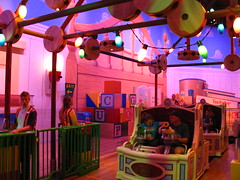 or the way vehicles suddenly yank and spin you from one level to the next imbuing the game with a physical sense of urgency… it’s impossible to make this formula more entertaining without controlled substances. And I’m not being (completely) sarcastic. Ride it once for what will seem like the second-best four minutes of your life so you’ll never have to bother again. Beware, the line fills up fast, so get a FastPass early in the day and do it quick before Mr. Potato Head has another aneurysm.
or the way vehicles suddenly yank and spin you from one level to the next imbuing the game with a physical sense of urgency… it’s impossible to make this formula more entertaining without controlled substances. And I’m not being (completely) sarcastic. Ride it once for what will seem like the second-best four minutes of your life so you’ll never have to bother again. Beware, the line fills up fast, so get a FastPass early in the day and do it quick before Mr. Potato Head has another aneurysm.
Grade: C
The Magic of Disney Animation
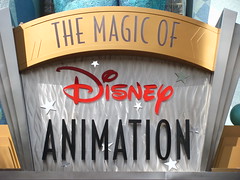 This indoor complex houses several different attractions, including a show about animated character development, costumed character meet-and-greets (there are always meet-and-greets at Disney parks, and they often command some of the longest lines), interactive games, and a museum of Disney animation artwork. The combination live/projected show actually does offer some worthwhile insights into Disney’s creative process, even if the show writers seemed to lack confidence over the audience’s sustained interest in this material by overstuffing the script with throwaway gags. The interactive activities on the main floor are fairly unremarkable, not helped by the recent proliferation of the App marketplace that now makes large computer kiosks housing mini-games such as these almost entirely redundant.
This indoor complex houses several different attractions, including a show about animated character development, costumed character meet-and-greets (there are always meet-and-greets at Disney parks, and they often command some of the longest lines), interactive games, and a museum of Disney animation artwork. The combination live/projected show actually does offer some worthwhile insights into Disney’s creative process, even if the show writers seemed to lack confidence over the audience’s sustained interest in this material by overstuffing the script with throwaway gags. The interactive activities on the main floor are fairly unremarkable, not helped by the recent proliferation of the App marketplace that now makes large computer kiosks housing mini-games such as these almost entirely redundant. It’s cute that a program script can determine after six short questions that if I were a Disney character I would be Jafar from Aladdin (I couldn’t disagree), but in this decade do I really still need to travel to Florida for that information? The adjoining museum about Disney animation is perhaps the most worthwhile, even if (and perhaps this is simply due to the nature of animation) the exhibits are very two-dimensional and the experience is akin to a coffee table book you have to read while standing. Nevertheless I walked away with some newfound appreciation for the artwork in a number of classic and recent animated films I hadn’t previously given as much consideration to, which seems like a solid signal that this gallery must be a success.4
It’s cute that a program script can determine after six short questions that if I were a Disney character I would be Jafar from Aladdin (I couldn’t disagree), but in this decade do I really still need to travel to Florida for that information? The adjoining museum about Disney animation is perhaps the most worthwhile, even if (and perhaps this is simply due to the nature of animation) the exhibits are very two-dimensional and the experience is akin to a coffee table book you have to read while standing. Nevertheless I walked away with some newfound appreciation for the artwork in a number of classic and recent animated films I hadn’t previously given as much consideration to, which seems like a solid signal that this gallery must be a success.4
The Twilight Zone Tower of Terror
Tower of Terror could make the best argument of any Disney ride that a theme park attraction could be considered as a uniquely singular category of artistic storytelling. It’s not that there aren’t better or more artistically competent Disney attractions (although the list is very short), but it is the only one that makes the exclusive experiential capability of thrill ride hardware and environmental immersion an absolutely essential component to the articulation of a detailed narrative. As great – in fact, greater – as the similarly weird and wonderful Haunted Mansion is, the slow-moving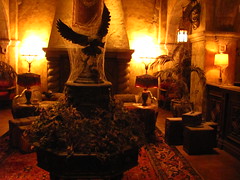 vehicles gliding gently past a fixed series of scenes could be translated into a different visual story medium without significant compromise, whereas a plot in which the audience must personally experience a zero-gravity freefall down an elevator shaft could not be replicated anywhere outside the theme park medium.5 The story, culled from an episode of the Twilight Zone, offers a breathtaking impression of Hollywood’s Golden Age as a source of simultaneous beauty and moral decay, cursed by the specter of time as familiar objects (including our own faces) phase in and out of the stardust from whence we came. In no other work of fiction has the existential dread rising from the pit of our stomach been felt so literally.
vehicles gliding gently past a fixed series of scenes could be translated into a different visual story medium without significant compromise, whereas a plot in which the audience must personally experience a zero-gravity freefall down an elevator shaft could not be replicated anywhere outside the theme park medium.5 The story, culled from an episode of the Twilight Zone, offers a breathtaking impression of Hollywood’s Golden Age as a source of simultaneous beauty and moral decay, cursed by the specter of time as familiar objects (including our own faces) phase in and out of the stardust from whence we came. In no other work of fiction has the existential dread rising from the pit of our stomach been felt so literally.
Yet while Tower of Terror could make the strongest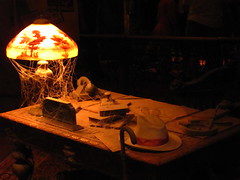 argument for the story-ride fusion as a unique artistic medium, I’m frustrated by certain aspects that weaken this position. There are hints of intriguing ideas that could form the bedrock of a great popular science fiction story; e.g. Hollywood’s downfall reinterpreted as a modern Icarus myth featuring an iconic tower that reached for the sun only to fall when it got too close, or the notion that the familiar world is an illusory construct of ancient metaphysical entities. However there’s also a sense that any deeper interpretations are mere thematic ghosts left behind from the television show, and discussion over the story’s meaning would be more relevant to the source material than the watered-down remix in the attraction. Most of the narrative details are isolated to the corner of a dark room where a sixteen inch television screen6 quickly answers
argument for the story-ride fusion as a unique artistic medium, I’m frustrated by certain aspects that weaken this position. There are hints of intriguing ideas that could form the bedrock of a great popular science fiction story; e.g. Hollywood’s downfall reinterpreted as a modern Icarus myth featuring an iconic tower that reached for the sun only to fall when it got too close, or the notion that the familiar world is an illusory construct of ancient metaphysical entities. However there’s also a sense that any deeper interpretations are mere thematic ghosts left behind from the television show, and discussion over the story’s meaning would be more relevant to the source material than the watered-down remix in the attraction. Most of the narrative details are isolated to the corner of a dark room where a sixteen inch television screen6 quickly answers the perfunctory Who-What-Where-When bullet points from the storyteller’s manual while leaving the more interesting questions of How and Why largely unanswered. Perhaps this could be seen as a minimalist approach to story intended to foster suspense and encourage visitors to reach their own conclusions, but more realistically this brief and overly-expository video suggests that engagement with such questions was never intended in the first place. As long as the preshow provides adequate justification for the falling elevator concept and finishes with an eerie feeling of mystery, it matters not if the story has any deeper independent meaning. In this case “story” or “theme” becomes a means to an end: it’s window dressing there for those who would admire it the same way as they will distantly admire the set design or special effects,
the perfunctory Who-What-Where-When bullet points from the storyteller’s manual while leaving the more interesting questions of How and Why largely unanswered. Perhaps this could be seen as a minimalist approach to story intended to foster suspense and encourage visitors to reach their own conclusions, but more realistically this brief and overly-expository video suggests that engagement with such questions was never intended in the first place. As long as the preshow provides adequate justification for the falling elevator concept and finishes with an eerie feeling of mystery, it matters not if the story has any deeper independent meaning. In this case “story” or “theme” becomes a means to an end: it’s window dressing there for those who would admire it the same way as they will distantly admire the set design or special effects, and for everyone else it’s an excuse to put a drop tower ride in a Disney park. Given that the majority of people will exit chattering excitedly over what the ride did rather than what the ride was about, I can’t help but feel that for all Tower of Terror does right, the formula to make theme park attractions a “story-first” medium has yet to find the perfect balance.
and for everyone else it’s an excuse to put a drop tower ride in a Disney park. Given that the majority of people will exit chattering excitedly over what the ride did rather than what the ride was about, I can’t help but feel that for all Tower of Terror does right, the formula to make theme park attractions a “story-first” medium has yet to find the perfect balance.
Grade: B+
Rock ‘n’ Roller Coaster
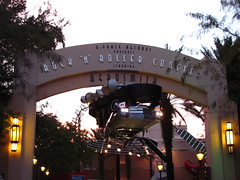 Okay Disney, we get it: you can be just as much of a badass as Universal Studios. The regrettably short-lived Hard Rock Park still beat both of your attempts at rock idolatry, as that property was created by people who evidenced a true love for the music unlike these poseurs sitting at the cool kid’s table in central Florida. So, Rock ‘n’ Roller Coaster is actually a pretty good Disney attraction while simultaneously being a pretty mediocre roller coaster.7 The show portion of the attraction (i.e. everything built by Imagineers) is simultaneously very “counter-Disney” while also extremely “classic Disney”, and I respect the balancing act needed to make this original concept (at the time) work. The visual aesthetic, which transitions from an ultra-modernist recording studio (the attraction’s “cover art”, as it were) to a dark and grungy backstage area
Okay Disney, we get it: you can be just as much of a badass as Universal Studios. The regrettably short-lived Hard Rock Park still beat both of your attempts at rock idolatry, as that property was created by people who evidenced a true love for the music unlike these poseurs sitting at the cool kid’s table in central Florida. So, Rock ‘n’ Roller Coaster is actually a pretty good Disney attraction while simultaneously being a pretty mediocre roller coaster.7 The show portion of the attraction (i.e. everything built by Imagineers) is simultaneously very “counter-Disney” while also extremely “classic Disney”, and I respect the balancing act needed to make this original concept (at the time) work. The visual aesthetic, which transitions from an ultra-modernist recording studio (the attraction’s “cover art”, as it were) to a dark and grungy backstage area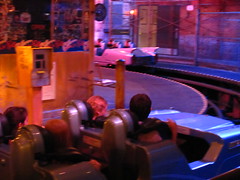 (where the heart of rock ‘n’ roll is found), are both quite different from anything else found on Walt Disney World property with its traditional focus on reassuring fantasies and nostalgia. Yet the Rock ‘n’ Roller Coaster is hardly antiestablishment, as most of the traditions of Disney design are still present underneath it all; from the series of enchanted portals that gradually take us someplace removed from the everyday, to the abundant nostalgia that comforts us like a friendly hug… only this time for a generation that cherishes memorabilia from The Doors or Jimi Hendrix Experience rather than the typical 1950’s cultural iconography of other Disney parks. Unfortunately the coaster portion of the attraction (i.e. everything built by Vekoma) is also pretty last generational as well. Predictably there’s no sense of how to pace a layout so it’s exciting
(where the heart of rock ‘n’ roll is found), are both quite different from anything else found on Walt Disney World property with its traditional focus on reassuring fantasies and nostalgia. Yet the Rock ‘n’ Roller Coaster is hardly antiestablishment, as most of the traditions of Disney design are still present underneath it all; from the series of enchanted portals that gradually take us someplace removed from the everyday, to the abundant nostalgia that comforts us like a friendly hug… only this time for a generation that cherishes memorabilia from The Doors or Jimi Hendrix Experience rather than the typical 1950’s cultural iconography of other Disney parks. Unfortunately the coaster portion of the attraction (i.e. everything built by Vekoma) is also pretty last generational as well. Predictably there’s no sense of how to pace a layout so it’s exciting to the very end. The launch is cool (the use of lighting makes it look much faster than it really is, about twice as strong as a commercial airliner takeoff) and it immediately pours into the signature double rollover maneuver. After that the bulky limo-train lumbers around a series of flat geometric curves and block brakes with a lone corkscrew making a cameo appearance at some arbitrary midpoint. Basically a rip-off of the Premier-built Flight of Fear coasters that opened three years prior, lacking are the nimble directional changes, strategic lulls and crescendos, and final corkscrew that forcefully informs you of the finish. Of course the coaster component isn’t all that matters, but given that Disney thought it mattered enough to break the diegetic construct and put “Roller Coaster” in the very title, I don’t feel out of line asking for better.
to the very end. The launch is cool (the use of lighting makes it look much faster than it really is, about twice as strong as a commercial airliner takeoff) and it immediately pours into the signature double rollover maneuver. After that the bulky limo-train lumbers around a series of flat geometric curves and block brakes with a lone corkscrew making a cameo appearance at some arbitrary midpoint. Basically a rip-off of the Premier-built Flight of Fear coasters that opened three years prior, lacking are the nimble directional changes, strategic lulls and crescendos, and final corkscrew that forcefully informs you of the finish. Of course the coaster component isn’t all that matters, but given that Disney thought it mattered enough to break the diegetic construct and put “Roller Coaster” in the very title, I don’t feel out of line asking for better.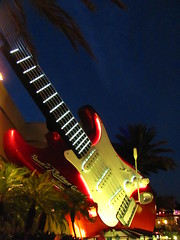
Grade: C+
Summary
A typical product of Hollywood’s most self-congratulatory impulses, some high-grade attractions save Disney’s Hollywood Studios from obsolescence in the competitive Orlando market.
Overall Grade: C

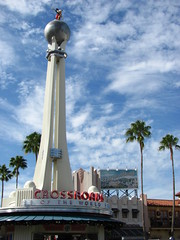
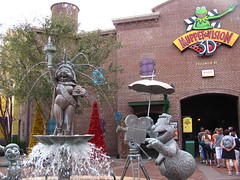
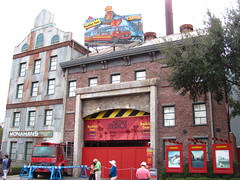
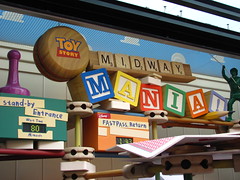
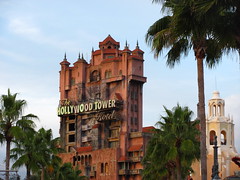
Footnotes & Annotations
[1] Which technically all theme parks have, only here the warehouse-like attraction show buildings don’t need to be hidden from sightlines, and it’s okay if the artificial sets are 2D and not completely convincing.
[2] Unsurprisingly, when the park was designed and built in the 1980’s both Disney and MGM Studios were at low points in their companies’ histories, as both of their glory days had long been forsaken by the new wave of Hollywood innovation.
[3] And is it any wonder the attraction this idea was implemented on is based on the film property most associated with rabid fans and marathon screenings?
[4] There’s also a collection of Oscar statues on display that’s cool to see in person; at least they would have been, if at the time they hadn’t been removed from its case for use as a prop in the upcoming “Saving Mr. Banks”, starring Tom Hanks as Walt Disney. What’s cooler for me at least was wen I went to check the IMDb to learn more about this film, on the film’s main page I discovered that one of my high school classmates had been cast in the film. Anna Roberts, as “Premiere girl”, actually had the lead role in the short film I made my senior year, which you can watch here. Perhaps Walt was right and it is a small world after all…
[5] This bears similarity to the debate whether or not video games can be considered art. Critics note that a game that appropriates other art forms (e.g. painted backdrops, background music, or cinematic cut-screens) cannot itself be considered a work of art, as the game only functions as a method of distribution for established art forms. Arguments that games belong in a separate artistic classification should be based on the unique ludic properties of the interactive format, rather than merely the content within that system. Thus the similarity to theme park attractions: if Tower of Terror is considered a work of art, it must be justified in the way it uses inhabited space and experiential systems, not just because it has a pleasing visual aesthetic or has an imaginative storyline.
[6] While there’s a lot to like about the preshow video’s function as a narrative framing device, ideally the point of using a themed environment is so that the story can inhabit an entire physical space. This is one aspect that the Tokyo version of Tower of Terror greatly improves upon. However I still insist that the original Orlando version is the best of the bunch in nearly every other aspect except for the limited use of space in the preshow room, with apologies to fans of the Shiriki Utundu.
[7] I don’t want that to sound like a superiority complex for coasters, since most good roller coasters would also be mediocre Disney attractions. Apples and oranges.
Well what do you know Jeremy? I actually agree with most of your review. I might quibble about the odd grade here and there, ( notably Tower off Terror where you spend a lot of time analysing the concept but precious little time talking about the actual ride which contains one of, to my kind, the most remarkable effects in any theme park anywhere), but generally speaking I think you pretty much nail this one.
I would however argue that your review is sadly lacking in one sense in that you omit at least half of the attractions. Hollywood Studios, more than any other park, relies on shows to bulk up it’s palate of attractions and they form a significant part of the park’s identity so to miss them out actually produces an imbalance in the review. Beauty and the Beast, The Little Mermaid, Walt Disney – One Man’s Story; these are good solid shows, sometimes innovative, but mostly highly entertaining. Less successful is the Car stunt show, although it’s worth seeing once. And then of course there’s Fantasmic. Without these any review of the Studios is only covering half the territory….
Thanks, it’s a relief to hear that I managed to get your opinions right in a review for once. 😉
About Tower of Terror, my main argument was that it shouldn’t be considered a ride with a themed storyline attached to it, but a way of telling a story that happens to use a theme park as its medium rather than film or theater, so focusing on specific mechanics or effects of the ride would sort of undermine that argument. I’ve written about the special effects and drop sequence twice before in the reviews for the ride in California and Paris, so I wanted to give this review a fresh focus on just the story and its themes. The point of the scores is so that aspects of an attraction I don’t specifically mention are implicit in the lettered grade.
The point about the shows brings up another topic I wanted to mention but couldn’t quite fit it in, which is related to FastPasses and the need to plan a day with flawless efficiency. As I recall I was this close to seeing the Little Mermaid show, but I either just missed the showtime by a minute or it was already filled to capacity when I got there or something like that. I don’t like to have dead time waiting for a show to start and I try to always have a FastPass in hand, which in this case made fitting the show schedules into the day a bit tricky if I didn’t time it just right, although I did get to do the Indy stunt show. I had planned on seeing Fantasmic, but two problems arose; 1. so did everyone else in the park, and 2. the Toy Story Mania FastPasses sold out so fast that by the time I got mine it was for the end of the night, meaning a choice of either Toy Story Mania or Fantasmic.
One thing that I should note was I had been led to expect that Hollywood Studios would only be a half-day park, so I went in expecting to circle around to hit all the majors and then fill time in with the shows wherever they may fall, but there ended up being enough to do that I didn’t realize I had missed most of the shows until it was already too late in the day.
That makes sense. I keep reading that Hollywood Studios is a half day park but we’ve always found that if we want to do everything you need a full day, and a long one at that, particularly as the show scheduling is not helpful. We’ve learnt that on park opening you run to pick up a Toy Story FastPass, (and we usually ride it once as a stand-by as it’s still only a 10 minute wait at that time of day), then head to Tower of Terror and Rock ‘n’ Roller Coaster. Once those are done we can usually get most of the rest of the stuff done in a day if we want to, although booking a Fantasmic Dinner Package is a good way of avoiding having to turn up for that 90 minutes before showtime.
To be honest this last time around we couldn’t be bothered with the ‘extreme planning’ schedule so we skipped Fantasmic, and Lights, Action but got round everything else in 3/4 of a day, (I’m excluding American Idol as I refuse to accept that as any kind of Disney attraction).
I suspect the ‘half day park’ myth is peddled by theme park enthusiasts who, unless it goes upside down, involves sudden acceleration, or throws you about physically in some manner, won’t ‘waste their time’ experiencing it.
Shame you missed the Little Mermaid as I actually thing it’s one of Disney’s more innovative shows in terms of staging, although I feel sorry for the live-action Mermaid actor who has to perform the same 18 minute show every 25 minutes!
Enjoyed the review, as always. I just wanted to comment on the thing about the use of the television in the Tower of Terror pre-show. Namely you ask why tell the story by TV, and then does the film shown actually leave more questions about the backstory which Disney could have explored upon. I actually think they nail this spot on. Why is most of the narrative told via the TV? – well, firstly, since it’s based on a Twilight Zone TV show, I guess there’s a nice ‘link’ there. But the way I see it is that throughout the queue, I understand this used to be a high-profile hotel, something creepy’s happened, something’s gone wrong – there’s a definite sense of fallen grandeur, a weird atmosphere, eerie mystery, and I am left with a number of questions. The lights go out in the library, and I like how all of the attention is focussed on the TV. I think the ‘less is more’ thing works perfectly here. It’s a massive scene shift, and is almost like I’m back in my house watching the Twilight Zone TV show. I actually see this moment as like a ‘flashback’ in a television show. You have the main plot and at points, we cut to flashbacks which help explain the main plot, but before we then cut back to the present with now a slightly clearer understanding. This works in the same way, and it is very much like a flashback in how different & minimalistic it is from the scale and epicness of the theming/surroundings of the main ‘plot’. The lights come on/we exit the library, massive scene shift again, and we’re now back in the main plot where we were a minute or two earlier, only now with a better idea of what’s happened at this hotel and a sense of nervousness about what we’re about to go through. But brilliantly, the film hasn’t gone over the top and answered all our questions – we know something paranormal is happening and it surrounds the elevator shaft, but that’s about it -and this adds to the sense of unknown and nervousness which we are feeling. So like how delivering the plot via the TV is minimalistic and has a degree of ‘less is more’, I think letting our mind fill in the blanks works well for this attraction. We need to be given a sense of narrative and a context for our experience, but I think to set everything in stone would be counter-productive – the attraction thrives on the mysteriousness and unexpectedness. Like in horror films, sometimes putting a twist on the simple ‘everyday’ things can have the greatest effect – or how giving the audience very little information and relying on the impact of suspense – I think the Tower of Terror works in the same way. Wouldn’t change any of the pre-lift experience at all! And also, very much agreeing about how this is one of the few examples of the ride hardware itself being fundamental to the plot – never thought of it like that before, but definitely a great point.
I have to agree with Alex. For me the TV screen works perfectly, but then I am old enough to remember watching the original Twilight Zone and so it seems entirely right and natural in the context of the overall experience. I also like the way the narrative is left ‘loose’ like many Disney attractions. You are given some information but to some extent you can let your imagination impose it’s own narrative upon that framework and I think that gives these attractions a strong sense of personal identity to people.
I am convinced that this narrative looseness is one of the reasons some Disney attractions seem to perform above expectations in polls and reviews because they are able to imprint themselves into people’s affections by a strong sense of individual ownership.
When I compared the preshow against the version in Tokyo (http://www.youtube.com/watch?v=a_gJvO-sc6k) I was careful to specify only that Tokyo’s use of space was “better” in the sense that it told a story through a physical environment (see footnote #5 above) rather than just appropriating a televisual media form for a couple of minutes. In terms of the actual story that the preshow space tells, I think Orlando’s is still much better, although I’ll save why I’m not a huge fan of the Tokyo storyline for later.
I agree that in the context of the Twilight Zone association the television works quite well, and in fact I would probably go even further by noting that this narrative element does a really good job of “framing” the story as something implicitly allegorical. In my opinion all stories need to have some sort of framing device, whether its the covers on a book or the credits before and after a movie; something that reinforces our background awareness that this is a finite story created by a storyteller of sorts, not like other theme park attractions in which when you enter them they’d like you to believe that their story continues off boundlessly into the infinite… mostly because in the latter form we’re not relating to it as an intentional work of art but as an event, and we’re thus less likely to mentally engage with the imaginative elements as we are if there’s a signifier that it’s a work of fiction.
When it comes to my criticisms of the script for the preshow film (which I said seemed like a short cut of a longer treatment), I think you both actually have my point backwards. My argument is that the current film is too limited in interpretive possibilities while too rigid on spelling out plot points. I remember on my first encounter with Tower I had a sense that the whole scenario was very allegorical although the exact interpretation of course could very wildly depending on who you ask. But I couldn’t get more detail about the story’s thematic concerns after the first ride, and upon subsequent visits that feeling left me entirely because the film is so focused on providing a rundown of the who-what-where-when concerns in as little time as possible that it doesn’t give any opportunity or encouragement to interpret it any deeper. Whatever it leaves out adding to the mystery, I consider it just that… a left-over mystery that no one bothered to develop any further. Maybe it helps contribute to a general eerie feeling but if it’s going to be a timeless classic then that feeling needs to have more going on beneath the surface. The suggested interpretations I offered (I’m pleased with the Icarus analogy, though I probably could have made the Tower of Babel work as well) are only that, a suggested interpretation. Anyone who considers a story as something that can be “solved” by the intended interpretation does not understand the basics of art or fiction. I’m glad on that point we all seem to be very much in agreement, even if it was expressed in different ways.
Put simply, I see the preshow film as a bare-bones summary that overlooked most of the subtle depths that gave the original Twilight Zone series their nuance, not an enigmatic riddle that teases hidden meaning beneath the surface. There’s only so far you can go to imposing your own meaning on a story where there is none, lest the allegory really becomes an emperor with no clothes.
I think the majority of regular theme park visitors believe that Disney would be better off it if either scrapped Fastpass altogether, or made it a paid system like the rest of the world has.
I begrudge fighting and rushing with my fellow park goers for the chance to ride things. I’d feel less aggravated had I known they splashed out extra cash for the privilege, because then, I can just see them as foolish and the Fastpass becomes a worthwhile thing. But currently, you’re a fool not to do it, yet everyone looses out if you do.
Hate it. And it purpose is to psychologically make the average guest feel better about their day – This must be of benefit because it cuts down my queue time! When really it’s an insult to their intelligence, because it’s making their day a planned, contrived mess and the lines longer ultimately longer.
I really liked Toy Story Mania and I hated that I liked it. It should be everything I detest… Screen based rides and dark rides which detract from their scenery with bullshit interactivity are pet hates of mine. But it works because it’s both of those things, whilst being energetic and visceral. It’s the poster child of what horrible dark rides should be like. Between the screens, theming was limited, and it didn’t matter because you were moving too fast and you were too concentrated on the screens. Compare that to other shooting dark rides, or even the likes of Spiderman, where the extravagant scenery is lost under the shooting interaction bollocks or the huge screen. Disney seem to have understood, finally. I wonder if it was fluke.
FastPass was another topic I wanted to touch in this review, but it didn’t quite fit in. There’s a lot that could be said about the inequity of line-jumping services, especially since they’re an almost perfect example of the violation of Kantian ethics; i.e. for the system to exist it mandates a certain amount of inequality among people within a park. I mind it less in Disney’s case, because it’s free and in theory anyone with the initiative can get one, so really all it does rearrange ride times to give higher priority to people with a strong desire to ride a certain attraction, which has a legitimate value I think, especially speaking as someone who’s interest is getting as many rides as possible rather than using queues as a chance to socialize with non-present friends or family.
I think the biggest disadvantage with Disney’s system is that it takes people out of queues and puts them back onto the midway. It doesn’t increase park capacity at all, but it shifts the existing capacity around in ways that is detrimental to most guest’s experience. The FastPast lanes frequently move too fast, such that I can’t take the time to study and enjoy the backstory that are typically provided in queues. The stand-by lanes now moves much slower and sporadically than they used to, which makes them rather odious places to spend time in and can kill my initial anticipation for an attraction by the time I finally make it to the front. (This was a particularly big problem when I did the stand-by for Spiderman at IOA.) And I can’t enjoy the themed storylines found throughout the midways as much because they’re always too crowded. I step out into the carefully designed plazas, and instead of appreciating the design I feel ambushed by the masses that fill this space, and my reaction is always “I’ve got to get another FastPass to get out of this ASAP.” Sure I can recognize that I’m playing into the viscous circle, but if I do the game theory calculation it’s clear that not partaking in the FastPass system will do me more harm than it will do anyone else any good.
It’s funny you should talk about FastPass and Toy Story Mania, as they both are perhaps the two parts of Disney that I most hate to love.
Just a note to everyone, I updated the second paragraph of the Tower of Terror review after considering some of the initial comments and making a few of my own adjustments to (hopefully) strengthen the argument and the flow of the prose. One of the purposes of capsule format was so that I could easily make updates like this, although this is the first time I have significantly done so. For anyone interested I copied the original edit below:
Yet while Tower of Terror could make the strongest argument for the story-ride fusion as a unique artistic medium, I’m frustrated that there are still certain aspects that weaken this position. If this is the crowning achievement of experiential storytelling, why is so much of the narrative delivered by a sixteen inch television screen in the corner of a dark room? The point of using a themed environment to communicate a story should be that it can use the entire physical space; this is one aspect that the Tokyo version of Tower of Terror greatly improves upon.[6] The short film played on the television I also find leaves something to be desired. It feels like there used to be a longer edit, and the one we currently watch has trimmed the backstory, character development, and thematic concerns down to the very nubs in order to hasten the preshow’s turnaround time. There are hints of intriguing ideas that could form the bedrock of a great popular science fiction story; e.g. Hollywood’s downfall interpreted as a modern Icarus myth with an iconic tower that reached for the sun only to fall when it got too close, or the notion that the familiar world is an illusory construct of ancient metaphysical entities. However none of these are developed enough for the casual audience member to hook onto, and instead the film only serves to redundantly reinforce information we already know: the time and place, the Twilight Zone affiliation with Rod Serling, that there’s a service elevator that drops, and that lightning is a clichéd special effect. As much as I’d like to think that The Twilight Zone Tower of Terror put story first and the ride system was just a means of telling this particular story, the treatment sometimes suggests it’s really just elaborate window dressing to excuse a drop tower ride in a Disney park, by inventing a high-concept scenario with an elevator and then letting the set designers run wild. I try to have more faith in the Imagineers than that, and even if the story really is all style and no substance, then oh what glorious style they’ve achieved.